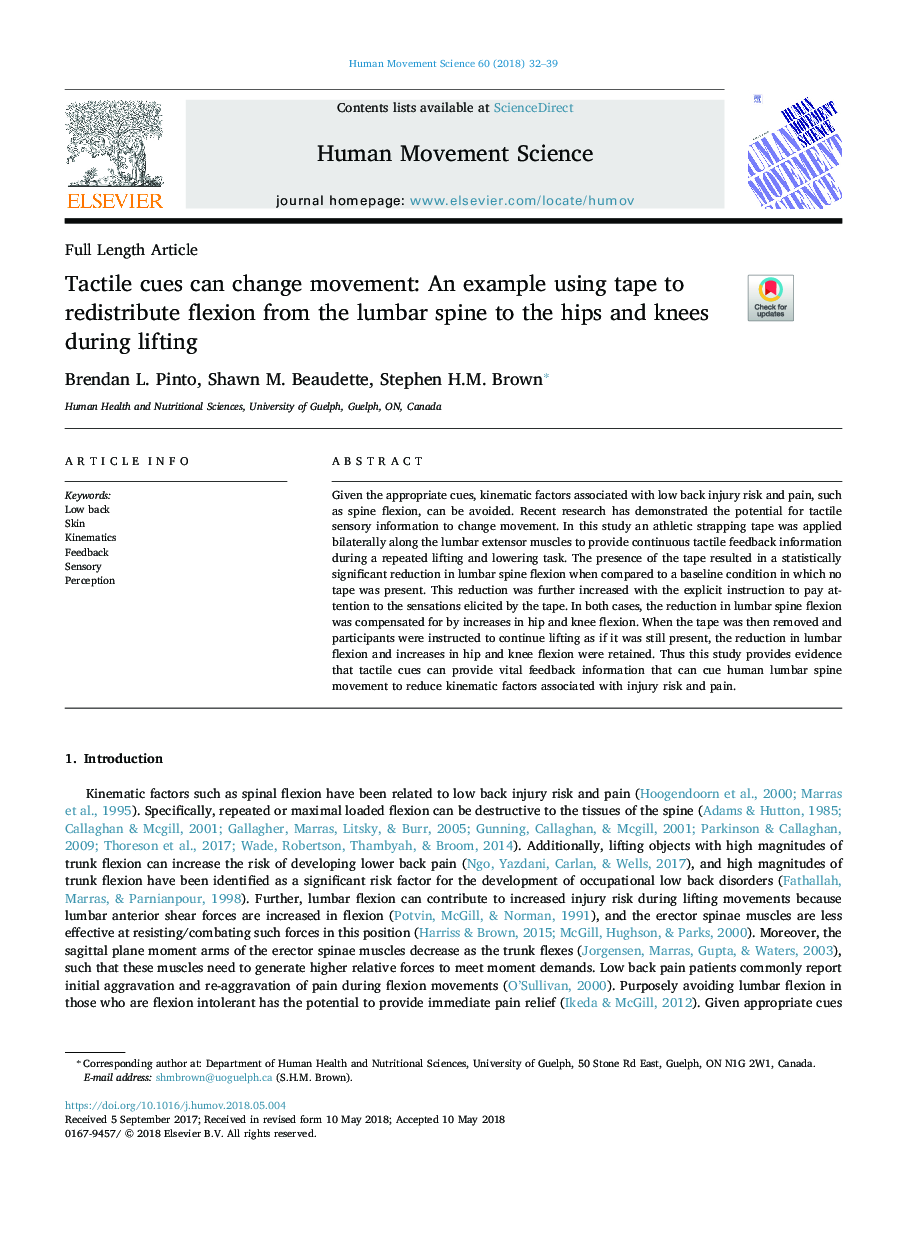| کد مقاله | کد نشریه | سال انتشار | مقاله انگلیسی | نسخه تمام متن |
|---|---|---|---|---|
| 7290762 | 1474204 | 2018 | 8 صفحه PDF | دانلود رایگان |
عنوان انگلیسی مقاله ISI
Tactile cues can change movement: An example using tape to redistribute flexion from the lumbar spine to the hips and knees during lifting
ترجمه فارسی عنوان
نشانه های تاکتیکی می توانند جنبش را تغییر دهند: نمونه ای با استفاده از نوار برای تغییر مجدد فلکسنج از ستون فقرات کمری به مفصل و زانو در طول بلند کردن
دانلود مقاله + سفارش ترجمه
دانلود مقاله ISI انگلیسی
رایگان برای ایرانیان
کلمات کلیدی
ترجمه چکیده
با توجه به نشانه های مناسب، عوامل سینماتیکی مرتبط با ریسک درد و آسیب کمر، مانند فلکسون ستون فقرات، می توانند اجتناب شود. تحقیقات اخیر پتانسیل اطلاعات حساسیتی لمسی را برای تغییر جنبش نشان داده است. در این مطالعه نوار تسمه ورزشی به صورت دو طرفه در امتداد عضلات انکسانس کمری قرار داده شده است تا اطلاعات بازخورد مختصر لمسی را در طی یک تکرار بلند کردن و کاهش کار انجام دهد. حضور نوار سبب کاهش قابل توجهی در فلکسون ستون فقرات کمری شد، در مقایسه با وضعیت اولیه که در آن هیچ نوار وجود نداشت. این کاهش با دستورالعمل صریح به توجه به احساسات ناشی از نوار افزایش یافت. در هر دو مورد، کاهش فلکسیون ستون فقرات کمری به علت افزایش انعقاد هیپ و زانو جبران شد. وقتی نوار پس از آن حذف شد و شرکت کنندگان دستور دادند که همچنان ادامه یابد، همانطور که هنوز وجود دارد، کاهش فلکسیون کمری و افزایش انعقاد مفصل ران و زانو حفظ شد. بنابراین این مطالعه شواهد نشان می دهد که نشانه های لمسی می توانند اطلاعات بازخورد حیاتی را فراهم کنند که می تواند حرکت جنبش ستون فقرات کمر انسان را کاهش دهد تا عوامل سینماتیک مرتبط با ریسک و درد را کاهش دهد.
موضوعات مرتبط
علوم زیستی و بیوفناوری
علم عصب شناسی
علوم اعصاب شناختی
چکیده انگلیسی
Given the appropriate cues, kinematic factors associated with low back injury risk and pain, such as spine flexion, can be avoided. Recent research has demonstrated the potential for tactile sensory information to change movement. In this study an athletic strapping tape was applied bilaterally along the lumbar extensor muscles to provide continuous tactile feedback information during a repeated lifting and lowering task. The presence of the tape resulted in a statistically significant reduction in lumbar spine flexion when compared to a baseline condition in which no tape was present. This reduction was further increased with the explicit instruction to pay attention to the sensations elicited by the tape. In both cases, the reduction in lumbar spine flexion was compensated for by increases in hip and knee flexion. When the tape was then removed and participants were instructed to continue lifting as if it was still present, the reduction in lumbar flexion and increases in hip and knee flexion were retained. Thus this study provides evidence that tactile cues can provide vital feedback information that can cue human lumbar spine movement to reduce kinematic factors associated with injury risk and pain.
ناشر
Database: Elsevier - ScienceDirect (ساینس دایرکت)
Journal: Human Movement Science - Volume 60, August 2018, Pages 32-39
Journal: Human Movement Science - Volume 60, August 2018, Pages 32-39
نویسندگان
Brendan L. Pinto, Shawn M. Beaudette, Stephen H.M. Brown,
